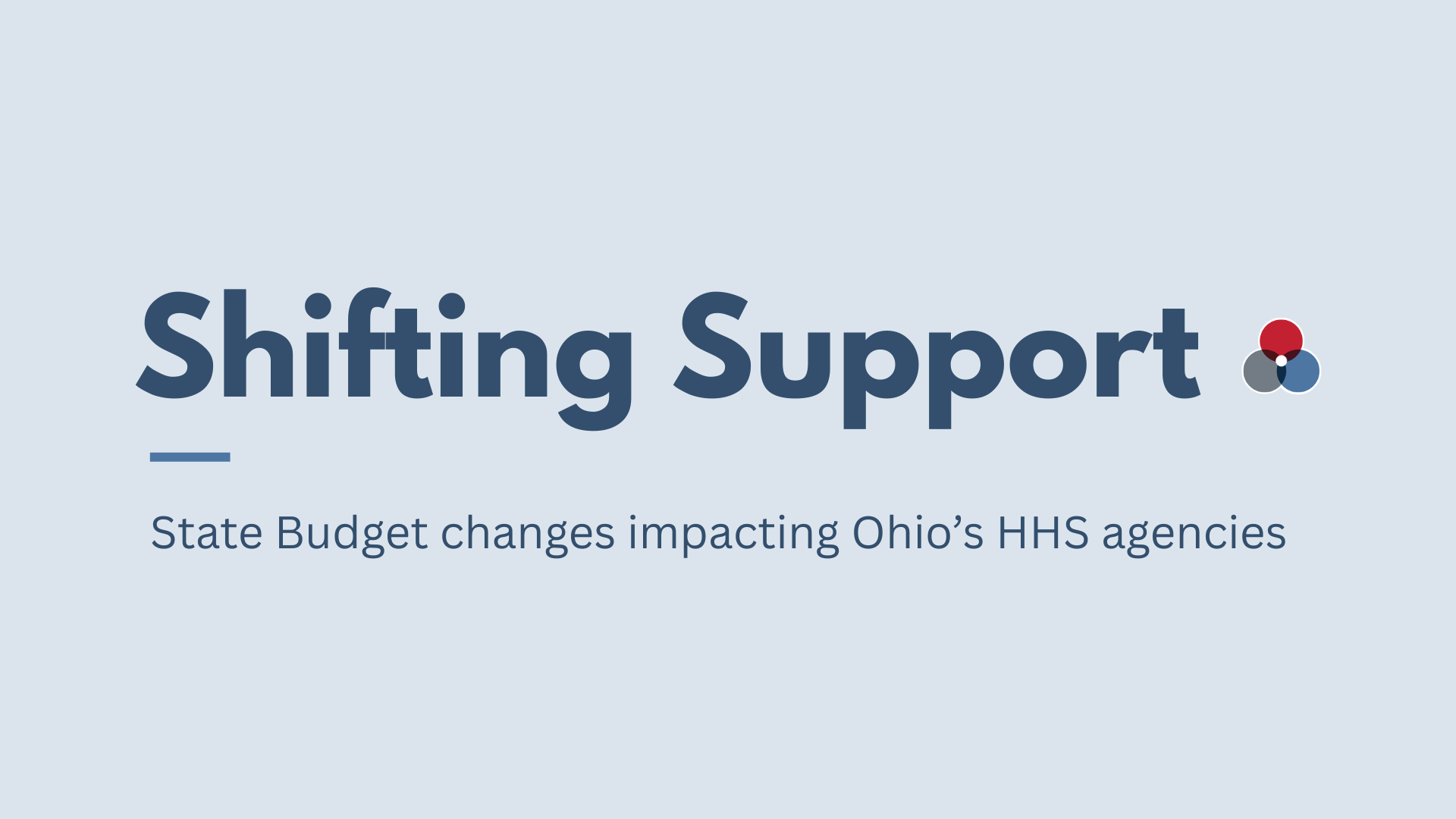Public benefits programs must be effective in both times of prosperity and times of economic downturn. Community Solutions recently wrote that it’s likely COVID-19 recovery will deepen the divide between low-income and middle-class Americans. As we look to the scheduled end of the Public Health Emergency Declaration in December 2021, it’s vital to continue support to families receiving public assistance as temporary COVID-19 aid ends.
In 2020, during the height of the COVID-19 pandemic, Ohio’s TANF program, called Ohio Works First, was relatively unresponsive to the economic recession compared to food assistance programs.
In 2020, during the height of the COVID-19 pandemic, Ohio’s Temporary Assistance for Needy Families (TANF) cash assistance program, called Ohio Works First (OWF), was relatively unresponsive to the economic recession compared to food assistance programs. Most public benefits programs are countercyclical to the economy – meaning that when the economy thrives, enrollment in benefits programs is low, and when the economy is struggling, enrollment in benefits increases. However, OWF barely expanded caseloads in spring and summer 2020 and quickly returned to pre-pandemic levels by the end of the year.
The structure of TANF creates barriers for the program to be a safety net for Ohioans in need. As Community Solutions has written in the past, the set amount of federal funding Ohio receives through the TANF block grant, as well as federal rules regarding work requirements, time limits, and other matters, somewhat limits the state’s ability to serve every needy Ohioan with TANF federal funds alone.
Throughout the COVID-19 pandemic, the Supplemental Nutrition Assistance Program (SNAP) received an influx of emergency funding to help state programs meet increased need. TANF programs did not see equal amounts of funding, and the funding that was received came in spring 2021, almost a year after the onset of the pandemic.
To support the SNAP program, the Families First Coronavirus Response Act, passed in March 2020, allowed states to suspend the SNAP three-month time limit for benefits for Able-Bodied Adults Without Dependents (ABAWDs), allowed states to provide emergency allotments (EAs) to SNAP households to increase their monthly benefit amount, and created the Pandemic-EBT (P-EBT) program, which provided meal replacement benefits to households whose children were eligible for free or reduced lunches at school, but whose schools were closed at any point during the 2019-2020 school year. The P-EBT program was later extended through summer 2021.[1]
In contrast, the only TANF funding authorized through COVID-19 relief packages was the Pandemic Emergency Assistance Fund, established by the American Rescue Plan Act of 2021, which provided $33.9 million[2] to Ohio to provide non-recurrent, short-term benefits – lasting less than four months – to needy Ohioans, meaning these funds could not be used to expand the OWF program[3]. Because of the restrictions placed on these dollars, it’s likely these dollars were used to fund Ohio’s Prevention, Retention and Contingency (PRC) program, a diversion program that offers short-term help to families for car repairs, rent, home maintenance, and other expenses that might otherwise lead to a family falling deeper into poverty.
Ohio Works First Data
In both 2019 and 2020, the yearly average payment to Ohio Works First enrollees was just over $210 per month, which works out to about $2,520 per year. If a three-person family makes 50 percent of the federal poverty level (FPL) – the maximum income possible while still being eligible for OWF – the average cash payments delivered through OWF would only bring a family to $742 per month, or $13,380 per year, which is about 62 percent of the federal poverty level for a family of three in 2020. According to the Administration for Children and Families at the U.S. Department of Health and Human Services, in 2019, only 6.8 percent of Ohio Works First recipients had income outside of cash assistance payments.[4]
In 2019, only 6.8 percent of Ohio Works First recipients had income outside of cash assistance payments.
As Tables 1-3 illustrate, the total number of Ohio Works First enrollees in both 2019 and 2020 was less than 1 percent of Ohio’s population. In 2019, the Census Bureau’s American Community Survey estimated Ohio’s statewide poverty level at 13.1 percent – meaning 13.1 percent of Ohio’s population had an income below the federal poverty level. Given that in 2019, 0.78 percent of Ohio’s entire population was enrolled in OWF, it’s estimated that only 6 percent of all Ohioans in poverty were enrolled. It’s important to note that not all Ohioans in poverty are eligible for OWF. The poverty rate calculates Ohioans at 100 percent FPL or less, and OWF eligibility is set to 50 percent FPL. OWF is also only available for families with children who meet income requirements.
Comparison to SNAP
In contrast to TANF cash assistance, the Supplemental Nutrition Assistance Program (SNAP), formerly known as food stamps, is an entitlement program. Each year, the federal government fully funds the cost of SNAP benefits provided to individuals, even if program enrollment fluctuates. The state must only help cover the cost of administering the program.
Each year, the federal government fully funds the cost of SNAP benefits provided to individuals, even if program enrollment fluctuates.
Because of the flexibility of SNAP funding to adjust based on the number of needy individuals, SNAP enrollment numbers are reactive to changes in the economy: as the economy goes up, SNAP enrollments go down. By the same token, as the COVID-19 pandemic stalled jobs, education and food access, SNAP enrollment went up.
Eligibility for SNAP benefits is set at a much higher level than OWF eligibility. To be eligible for SNAP, a household’s gross monthly income must be at or below 130 percent of the federal poverty level, and a household’s net monthly income must be less than or equal to 100 percent of the poverty level.[5]
Response to COVID-19 Pandemic
In April 2020, when the full force of COVID-related layoffs and shutdowns began, there was an increase in OWF caseloads among both adults and children. In June 2020, rolls peaked at 104,404, about 15,000 above pre-pandemic levels.[6] Using pre-pandemic numbers as a baseline, in January 2020, 91,111 Ohioans were enrolled and in February 2020, 90,145 Ohioans were enrolled. By December 2020, caseloads were back to pre-pandemic levels, at 90,483 Ohioans enrolled. This was well before a vaccine was widely available, public health orders were lifted or many jobs were restored. Over April, May and June 2020 when pandemic shut-downs were in full effect, OWF caseloads increased just 16 percent.
SNAP, by comparison, expanded to include 300,000 additional enrollees in just one month, between March 2020 and April 2020, and as of May 2021, was still 200,000 above pre-pandemic caseloads. Unlike OWF caseloads, SNAP rolls increased 23 percent to accommodate higher need due to the pandemic, and SNAP expanded to include these additional enrollees just one month after COVID-19 shut downs caused widespread job loss and left many Ohioans in need.
In spring 2020, County Job and Family Services offices made emergency relief funding available through PRC. In normal times, PRC provides short-term help to low-income families to help with emergent needs, such as one-time rental assistance, auto repair expenses, and disaster assistance, among others.[7]
The PRC emergency relief in early 2020 allocated one-time payments to families with children who made less than 200 percent of the federal poverty level.
The PRC emergency relief in early 2020 allocated one-time payments to families with children who made less than 200 percent of the federal poverty level. In Hamilton County, $3 million to fund $500 payments to families was exhausted just five hours after applications were opened.[8] In Montgomery County, $1.2 million of funding for payments of up to $1,000 was exhausted in less than two days.[9] In Franklin County, $1.5 million in funding for $500 payments was spoken for in just 24 hours.[10]
The high demand for these PRC payments shows that low-income Ohioans were struggling at the onset of pandemic shut-downs and could have benefited from a more responsive and substantial cash assistance program.
County-Level Data
Ohio Works First is not the safety net that Ohioans need. OWF leaves out many families in poverty. Under the Aid to Families with Dependent Children (AFDC) entitlement program, the predecessor to TANF, direct cash assistance made up the single largest use of federal funding in every state. Under TANF, however, many states spend less than one-fifth of their TANF funds on cash assistance. Ohio spends just over 20 percent of its TANF funds on the Ohio Works First program.[11]
Ohio spends just over 20 percent of its TANF funds on the Ohio Works First program.
In Tables 8A and 8B, the sharp decline in enrollment numbers in Ohio Works First between June 2020 and May 2021 show how quickly OWF caseloads returned to pre-pandemic levels, even as the federal public health emergency remained in effect and many Ohioans continued to struggle. SNAP caseloads, however, have changed little since June 2020, offering the assistance that Ohioans still need as the economy recovers.
Table 8A: Number of OWF Recipients for Counties with ACS Poverty Rates Greater Than 15.0%
Includes only counties with a 15.0% poverty rate or higher. June 2020 numbers used for comparison because OWF case numbers in 2020 were highest in June.
The number of Ohioans left out of the OWF program can be starkly seen when examining county by county data, where many counties have fewer than 10 adult recipients, even in the midst of a pandemic.
Conclusion
Not all states’ cash assistance programs remained as inflexible during the pandemic as Ohio’s. In Minnesota, March 2020 Executive Orders from Governor Tim Walz waived work requirements, requirements for in-person visits to prove continued eligibility, and time limits. Some Minnesota county offices began to accept verbal consent for applications over the phone, rather than requiring paper forms.[26]
Delaware, Maine, New Hampshire, Rhode Island, Washington and Wisconsin also suspended time limits during the COVID-19 pandemic. Delaware increased every household’s benefits to the maximum level, Maryland increased benefits to $100 per household member per month for up to six months, and Pennsylvania gave one-time grants to cash assistance recipients equal to two months of cash benefits.[27]
Ohio Works First can’t be left out when building a strong, interconnected safety net for Ohioans when they need it most.
Ohio could have taken the same steps, but instead, only relaxed work requirements during the pandemic.[28] While the federal government can unilaterally expand SNAP benefits and remove program requirements that pose barriers for some recipients, only states can choose to relax TANF cash assistance requirements and expand benefits for their own cash assistance programs in times of economic crisis, with the agreement of the federal government. As one of only a small number of cash assistance programs available to low-income Ohioans, Ohio Works First can’t be left out when building a strong, interconnected safety net for Ohioans when they need it most.
[1] States are Using Much-Needed Temporary flexibility in SNAP to Respond To COVID-19 Challenges. Center on Budget and Policy Priorities. (2021, June 3). https://www.cbpp.org/research/food-assistance/states-are-using-much-needed-temporary-flexibility-in-snap-to-respond-to.
[2] Administration for Children & Families, Office of Family Assistance, Pandemic Emergency Assistance Fund Allotment - States (n.d.). https://www.acf.hhs.gov/sites/default/files/documents/ofa/State-pandemic-emergency-asssistance-fund-allotment-Table.pdf.
[3] Office of Family Assistance, TANF-ACF-PI-2021-02 (The Pandemic Emergency Assistance Fund) (2021). Administration for Children & Families, Office of Family Assistance. https://www.acf.hhs.gov/ofa/policy-guidance/tanf-acf-pi-2021-02.
[4] Administration for Children & Families, Characteristics and Financial Circumstances of TANF Recipients Fiscal Year (FY) 2019 (n.d.). https://www.acf.hhs.gov/sites/default/files/documents/ofa/fy19%5Fcharacteristics%5Ffinal.pdf.
[5] Center on Budget and Policy Priorities. (2019). (issue brief). Policy Basics: The Supplemental Nutrition Assistance Program (SNAP). Retrieved from https://www.cbpp.org/research/food-assistance/the-supplemental-nutrition-assistance-program-snap
[6] Ohio Department of Job and Family Services, Caseload Summary Statistics Report June 2020 (n.d.). https://jfs.ohio.gov/pams/Caseload-Summary-Report-June--2020.stm.
[7] Ohio Department of Job and Family Services, Fact Sheet: Prevention, Retention and Contingency (2021). https://jfs.ohio.gov/factsheets/prc.pdf.
[8] Coronavirus notebook: $500 checks go fast. (2020, April 7). Cincinnati Business Courier. https://www.bizjournals.com/cincinnati/news/2020/04/07/coronavirus-notebook-500-checks-go-fast-virtual.html.
[9] Balduf, J. (2020, April 9). Coronavirus: Applications cut off for low-income families seeking short-term help. Dayton Daily News. https://www.daytondailynews.com/news/local/coronavirus-applications-cut-off-for-low-income-families-seeking-short-term-help/P4rypxdrCZPJ5g3atjX5XN/.
[10] Kovac, M. (2020, April 3). $1.5 Million in Franklin County coronavirus assistance exhausted in 24 hours. The Columbus Dispatch. https://www.dispatch.com/news/20200403/15-million-in-franklin-county-coronavirus-assistance--exhausted-in-24-hours.
[11] Safawi, A., & Schott, L. (2021). (rep.). To Lessen Hardship, States Should Invest More TANF Dollars in Basic Assistance for Families. Center on Budget and Policy Priorities. Retrieved from https://www.cbpp.org/research/family-income-support/to-lessen-hardship-states-should-invest-more-tanf-dollars-in-basic
[12] U.S. Census Bureau, American Community Survey 2019 5-year estimates
[13] Ohio Department of Job and Family Services, Caseload Summary Statistics Report June 2020 (n.d.). https://jfs.ohio.gov/pams/Caseload-Summary-Report-June--2020.stm.
[14] Ohio Department of Job and Family Services, Caseload Summary Statistics Report May 2021 (n.d.). https://jfs.ohio.gov/pams/Caseload-Summary-Report-May-2021.stm.
[15] Ohio Department of Job and Family Services, Caseload Summary Statistics Report June 2020 (n.d.). https://jfs.ohio.gov/pams/Caseload-Summary-Report-June--2020.stm.
[16] Ohio Department of Job and Family Services, Caseload Summary Statistics Report May 2021 (n.d.). https://jfs.ohio.gov/pams/Caseload-Summary-Report-May-2021.stm.
[17] U.S. Census Bureau, American Community Survey 2019 5-year estimates
[18] Ohio Department of Job and Family Services, Caseload Summary Statistics Report June 2020 (n.d.). https://jfs.ohio.gov/pams/Caseload-Summary-Report-June--2020.stm.
[19] Ohio Department of Job and Family Services, Caseload Summary Statistics Report May 2021 (n.d.). https://jfs.ohio.gov/pams/Caseload-Summary-Report-May-2021.stm
[20] Ohio Department of Job and Family Services, Caseload Summary Statistics Report June 2020 (n.d.). https://jfs.ohio.gov/pams/Caseload-Summary-Report-June--2020.stm.
[21] Ohio Department of Job and Family Services, Caseload Summary Statistics Report May 2021 (n.d.). https://jfs.ohio.gov/pams/Caseload-Summary-Report-May-2021.stm.
[22] Ohio Department of Job and Family Services, Caseload Summary Statistics Report June 2020 (n.d.). https://jfs.ohio.gov/pams/Caseload-Summary-Report-June--2020.stm.
[23] Ohio Department of Job and Family Services, Caseload Summary Statistics Report May 2021 (n.d.). https://jfs.ohio.gov/pams/Caseload-Summary-Report-May-2021.stm.
[24] Ohio Department of Job and Family Services, Caseload Summary Statistics Report June 2020 (n.d.). https://jfs.ohio.gov/pams/Caseload-Summary-Report-June--2020.stm.
[25] Ohio Department of Job and Family Services, Caseload Summary Statistics Report May 2021 (n.d.). https://jfs.ohio.gov/pams/Caseload-Summary-Report-May-2021.stm.
[26] Goldstein, A. (2021, August 1). Welfare rolls decline during the pandemic despite economic upheaval. The Washington Post. https://www.washingtonpost.com/health/2021/08/01/welfare-roles-during-the-pandemic/.
[27] Goldstein, A. (2021, August 1). Welfare rolls decline during the pandemic despite economic upheaval. The Washington Post. https://www.washingtonpost.com/health/2021/08/01/welfare-roles-during-the-pandemic/.
[28] Goldstein, A. (2021, August 1). Welfare rolls decline during the pandemic despite economic upheaval. The Washington Post. https://www.washingtonpost.com/health/2021/08/01/welfare-roles-during-the-pandemic/.








